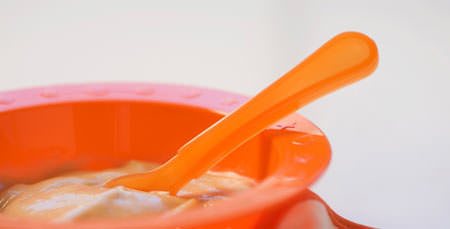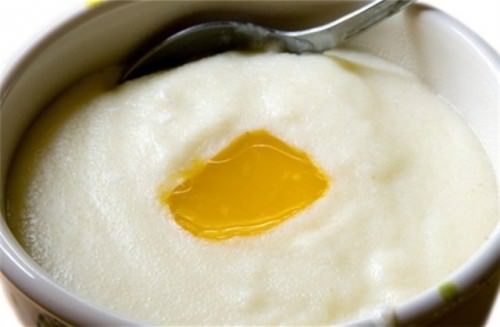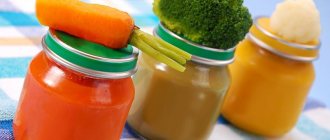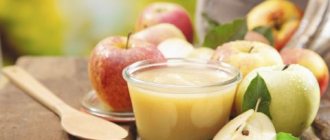If a woman has had her first child, she is often somewhat confused. Immediately after giving birth, she does not know how to breastfeed, how to swaddle, or how to hold the baby. When the baby begins to grow, many new questions arise: when to introduce complementary foods, how to develop physically and mentally, how to educate? Everything comes with experience; you shouldn’t think that it’s given to someone from above. With each subsequent child, parents become more and more confident. They don't worry about little things and know how to behave in an emergency situation.
Timing of introduction of complementary foods
The question of the age to start feeding a baby is always relevant, and points of view regarding it are somewhat different.
Thus, the World Health Organization recommends introducing complementary foods to breastfed children no earlier than 6 months, and this age is the minimum. Until this moment, the baby's needs are completely satisfied with mother's milk. And the stomach of a baby until six months is not ready to digest anything other than mother’s milk, since the enzymatic system, which ensures the proper digestion of “adult” food, is formed only by this age.
However, grandmothers of babies often advise starting to introduce complementary foods for infants, especially juices, at 3 months, citing the fact that this has been done before. Indeed, in the USSR it was customary to start introducing juices to children at such an early age, but this system was criticized and revised; at the moment, no complementary foods, even natural juices, are recommended to be introduced earlier than 6 months.
In rare cases, according to pediatrician indications, for example, in case of anemia, severe weight loss, complementary foods can be introduced earlier than 6 months.
How to prepare complementary foods for a baby?
Some mothers do not want to overexert themselves too much and therefore buy ready-made purees in the store. If you don’t have your own garden, it’s better to do so, because the market sells vegetables that are not of high quality. If you have the opportunity to provide vegetables from your own garden, there is no need to buy puree in the store. First of all, it's expensive. Secondly, it is not known what it is made of.
How to prepare vegetable puree? It is advisable to cook vegetables in a double boiler. This way they will retain all the vitamins and nutrients. Grind the prepared vegetables in a blender and add a little milk. If the baby is breastfed, the mother needs to express the milk and mix it with vegetables. Artificial, artificial mixture is added to vegetables.
How to prepare complementary foods for a baby? As for the porridge. It is better to buy dairy-free porridge, which is already crushed so much that you can simply steam it with milk. If you can’t buy such porridge, you can wash and dry the cereal, and then grind it in a coffee grinder. Then just boil it in milk.
Porridge for feeding infants
The most delicious milk for a baby is mother's milk, but over time the baby's needs increase and he needs less milk. It's time to introduce complementary foods. They usually start with vegetables, then give them porridge, and so on until the child is introduced to all the foods allowed for children.
Buckwheat porridge for complementary feeding of infants is considered the most useful, since it contains a huge amount of nutrients, vitamins and microelements. Buckwheat contains magnesium, iron, vegetable protein, potassium and phosphorus. Buckwheat porridge should be the first porridge that your baby gets acquainted with.
Rice porridge is considered hypoallergenic and contains vitamins and minerals. However, this porridge should not be given often, as it can cause constipation.
Mashed potatoes for feeding babies
Thirty years ago, children were given fruit puree as their first complementary food. Today doctors recommend starting with vegetable puree. You can buy it ready-made or prepare it yourself. Zucchini puree is most suitable for feeding infants. Children love the taste of zucchini and pumpkin. These vegetables do not cause allergies and have a positive effect on intestinal function.
Indicators for introducing complementary foods
There are indicators by which parents should assess whether the child is ready for the introduction of complementary foods. So, you can introduce complementary foods to an infant if he:
- reached the age of 6 months;
- knows how to sit independently;
- shows interest in his parents' food, reaches out to their plates and tries to taste the food;
- weighs 2 times more than at birth;
- began to ask for the breast more often;
- may turn his head away from the spoon if he does not like the food or drink;
- does not push the spoon out of the mouth with the tongue;
- healthy
If the child meets all the listed signs, you can introduce him to new, “adult” food. It should be remembered that at the time of introducing complementary foods, the baby must be absolutely healthy, he should not be in a state of stress caused by moving, changes in family composition, or the period of active teething.
Table of recommended foods for complementary feeding by month
| Child's age in months | Recommended Products |
| 6 | Vegetable puree from broccoli, cauliflower or zucchini. Later, you can introduce puree made from carrots or pumpkin into your diet. The puree should be made from only one of the listed products. You should not mix several different vegetables at once. |
| 7 | Porridge made from gluten-free cereals: buckwheat, corn or rice. They should be cooked in clean water. It is allowed to cook porridge with breast milk. |
| 8 | Mashed potatoes. Before cooking, soak the potatoes in water for 1 hour to release the starch. Knead it with the broth that formed when boiling potatoes, or with a small amount of breast milk. From 8 months you can also introduce boiled egg yolk, rabbit or turkey puree into the diet. |
| 9 | Natural yogurt, tender cottage cheese, kefir without any additives. Before giving regular cottage cheese to your baby, it should first be rubbed through a sieve. |
| 10 | Fruit puree made from green apples or pears. You can also add prune puree, apple and pear compote to your diet. |
| 11–12 | You can try introducing fish, crackers, fruits, oatmeal and semolina into your diet. |
It is not necessary to introduce all recommended foods into your baby’s diet at the same time. For complete complementary feeding, 2 products from the list will be enough.
Each product has its own properties, which you should pay attention to when introducing it into your baby’s diet. For example, rice porridge does not cause allergies. However, it can complicate the process of removing feces from the baby’s intestines. Prune puree, on the contrary, removes intestinal contents well. But it is contraindicated for children with loose stools.
Procedure for introducing complementary foods
There are two schemes for introducing complementary feeding to infants - traditional and pedagogical complementary feeding.
The traditional scheme involves introducing complementary foods in a certain order. This scheme is used by most mothers.

The first complementary foods should be low-allergenic foods. It is recommended to introduce one-component vegetable purees as the first complementary food. Vegetables suitable for early introduction include zucchini, cauliflower, and broccoli. Then you can add carrots, green peas, pumpkin, potatoes (pre-soaked in water for several hours). Mono-component purees can gradually be replaced by purees from two or more types of vegetables.
If a child is not gaining weight well, instead of vegetable puree, dairy-free porridge can be the first complementary food, but it is important that it does not contain gluten. Gluten-free porridges include buckwheat, rice and corn. Porridges containing gluten (wheat, oatmeal, multigrain) are best introduced after 9 months. At this time, you can start adding whole milk to them. Porridge is given once a day.
Each new product should be given before breastfeeding, in the morning, gradually, starting with half a teaspoon. Every day the amount of puree doubles and is thus brought up to the age norm. Each new product is offered 1-2 weeks after the already introduced one. In this case, the new product is given in addition to the old one; together, in terms of volume, they should constitute the age norm.
To monitor the child’s reaction to new foods, it is best to keep a food diary, where to write down what and when the baby ate and what reaction he had to the food. If, after introducing a new product, skin rashes, loose stools, or, conversely, constipation appear, then this food should be excluded from the diet for some time (about 1 month). If the baby does not like a certain product, he turns away from the spoon or spits it out, then there is no need to insist and force-feed. Such food should also be excluded for a while and offered after a while. Sometimes a child needs to be offered a product more than 10 times to get him to try it.

After introducing the first vegetables and cereals, you need to start adding a small amount of butter and olive oil (0.5-1 tsp) to dishes. Butter goes well with cereals, and olive oil goes well with vegetables. Oils contain fatty acids necessary for a growing body, primarily unsaturated ones (found in olive oil), and help with constipation.
From the age of 6-7 months, all drinks should be given to drink from a cup, and not from a bottle, so that the child learns this skill. Initially, an adult should hold the cup, but by the age of one year you can begin to let the child hold the cup himself. Plain water, weak tea, compotes without sugar, and highly diluted juices are suitable drinks.
From about 7 months, you can replace one of the breastfeedings with a full meal of regular food. For this, some hearty dish is best suited, for example, porridge or meat with vegetables.
From 7-8 months, you can introduce vegetable and meat broths into your baby’s diet. From 8 months, a child can already eat meat 2-3 times a week, primarily turkey and rabbit, which are the most low-allergenic. Then you can try chicken, beef and veal. The norm for meat up to 1 year is no more than 50 g per day. At this time, you can start giving your child rye and wheat bread, baby cookies, and crackers. Moreover, it is best if he eats these foods on his own, holding them in his hand. This is how the baby learns to chew and bite, thus training the gums, teeth, jaws, and masticatory muscles.
Egg yolk, which can be added to meat and vegetable dishes, is necessary for the child as a source of vitamin D. Therefore, from 7-8 months, this product should be present on the baby’s table.
At the same age, it is recommended to introduce fruits into children's diets. You should start with fruits with a low likelihood of allergies: green apples, pears, plums. If there are no negative reactions from the child, you can try other fruits: bananas, kiwi, peaches. Fruits are important in the diet because they contain large amounts of vitamins and fiber. Giving fruit purees at first, you should gradually move on to pieces of fruit, which should be given to the baby so that he learns to bite and chew.
Cottage cheese and fermented milk products such as kefir can be introduced into a baby's diet at the age of 8 months. It is better to buy special children's cottage cheese, kefir and yogurt or prepare them yourself.

From 9-10 months, 1-2 times a week, the baby can be offered fish as complementary food, the most suitable of which are cod, hake, pike perch, pollock, and sea bass.
It is better to use vegetables as a side dish for meat and fish dishes, since they help the production of bile and digestive enzymes, and the fiber they contain facilitates easier absorption of protein and the elimination of metabolic products.
As for juices, pediatricians do not recommend introducing them before 1 year. Early introduction of juices, especially undiluted ones, threatens the child with diseases of the gastrointestinal tract, since juice is a difficult product for the immature digestive system of children.
To feed your child, you can either use ready-made baby food in jars or boxes, or prepare the food yourself at home. It is better to either boil or steam vegetables and meat. Salt and sugar should not be used when cooking. Until 8-9 months, it is better to grind food with a blender, but gradually you can start kneading food with a fork so that the child gets used to the presence of pieces in food and develops chewing skills.
About juice and anemia
And now the numbers. Here is an example of the iron content of various food sources suitable for an infant and the infant's needs for it.
In breast milk, the iron content is insignificant in itself, about 0.04 mg per 100 g. But iron in breast milk has a unique bioavailability - 50-75%. No other product in the world provides this. Those. the absorbed amount in mcg/100 g is about 20-30.
In modern adapted mixtures, the content of ferrous sulfate is about 0.2-0.4 mg/100 g (in enriched mixtures 0.6 mg/100 g). Taking into account its bioavailability (which is about 20%), the absorbed amount ranges from 40 to 120 mcg/100 g.
According to WHO, 20 mcg/100 g is a sufficient amount to meet the needs of a child up to the age of 6-8 months on average. In mixtures in which there are no additional factors stimulating absorption, the iron content, as can be seen, is overestimated.
But in the milk formula that our mothers fed us, the iron content is two times less than in breast milk - 0.02 mg / 100 g. The bioavailability is low - 10%, and the amount of absorbed iron is only 2 μg / 100 g of the mixture .
Those. for a child who was bottle-fed at that time, the prevention of iron deficiency anemia was VERY relevant. Because from the available food he received less than 1/10 of the required amount.
This was especially true for premature babies, because their own reserves were minimal due to the shortened period of perinatal development and, as a rule, were depleted to a minimum level by 2 months.
Juices acted as at least some alternative to solving such a problem. Really AT LEAST SOMETHING. Because it is impossible to offer solid food (pieces, purees) to a child of physiological immaturity for complementary feeding. Exceptionally liquid. Such as juices and broths. So, juices. The iron content in fortified apple juice is about 0.4-0.5 mg/100 g. Bioavailability is 1-2%, i.e. about 4 mcg/100 g is absorbed.
That is why, by the age of physiological decrease in iron reserves in the body (about 4 months), the child should already have a SUFFICIENT amount of another source of iron in his diet - juice. At least this 100 g of juice per day. But if you give them to a child right away, he will, excuse me, die. That’s why they introduced it as early as possible in order to stretch out the period of adaptation. Smooth out the stress effect.
Why was the recommendation universal? The reason is simple - few pediatricians will understand whether the mother is really breastfeeding well without supplementing with cow's milk. And the recommendation must be standardized! Maybe the mother is lying or not communicating about the baby's nutritional habits. And the child suffers. That is why, based on the principle of the lesser evil, this recommendation was made universal. If there is any harm, it will be small compared to the problems of growth defects in a child in the first year due to poor nutrition with unadapted food.
That, in fact, is all... The main problem is that in the conditions of modern nutrition for children, the advantages of introducing juice have lost their relevance. And when there is no even dubious benefit, then what is left?
Pedagogical complementary feeding
Pedagogical complementary feeding is the introduction of new foods to a child in very small quantities - those that fit between the mother’s index and thumb. That is, parents offer their baby the same food that they are eating at the moment. Of course, the child will not be able to eat so much, but this is not the goal of pedagogical complementary feeding. The main thing in this scheme is to introduce the baby to new products and their tastes. And saturation will occur with breast milk, which the mother will supplement him with after receiving parental food. If the child likes the product, its volume can be gradually increased to 3 tsp. The advantages of pedagogical complementary feeding are that there is no need to force the child to try food, he learns to eat on his own, he does not have to grind the food and he gradually chooses the foods he likes. As a rule, by about a year the baby begins to eat adult food with pleasure.
With pedagogical complementary feeding, the baby is fed from the parent's table. But we must never forget that smoked, fried, fatty, salty foods are contraindicated for a child. You should not introduce him ahead of time to such products as sausages, sausages, semi-finished products, cakes, and pastries. The later such food reaches the baby’s table, the better it will be for his health.
Summarizing
The mother must decide which complementary feeding scheme to choose, because only she knows what is best for her child. A good option would be to introduce complementary foods for infants according to the traditional scheme using pedagogical complementary foods to develop the baby’s food interest.
By the age of 1 year, children already usually eat quite a lot of dishes: meat and vegetable purees, soups (preferably with vegetable broth), cereals, fruits, cottage cheese, kefir, cookies, bread.
When preparing dishes, you need to pay attention to their beautiful design and colorful dishes in order to interest the baby and awaken his appetite. When composing the diet of a small family member, you need to take into account his individual preferences and needs. The baby should be encouraged to be independent when eating - let him take pieces of food and carry them into his mouth, and hold the cup with his own hands. Of course, parents should help their child in this difficult matter, maintain the necessary level of safety and cleanliness around, but you should not turn every meal into a passive opening of the child’s mouth in front of a spoon with food. Let him become an active participant in the process!
In any case, when introducing a child to adult food, you need to use the rule of gradualness and caution, do not force him to eat, and listen to your baby’s wishes. It must be remembered that until 1-1.5 years of age, breast milk should be the main nutrition for the child. And the full cycle of introducing complementary foods takes on average 1 year, so there’s no need to rush. Then the child will not experience any unpleasant consequences, and he will develop a healthy relationship with food for life.










